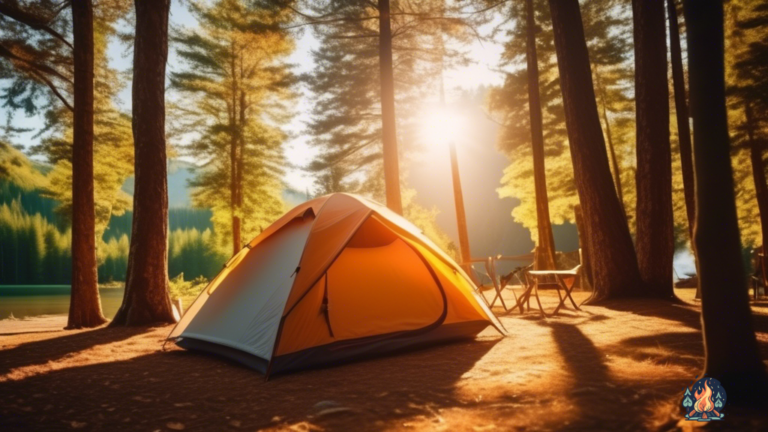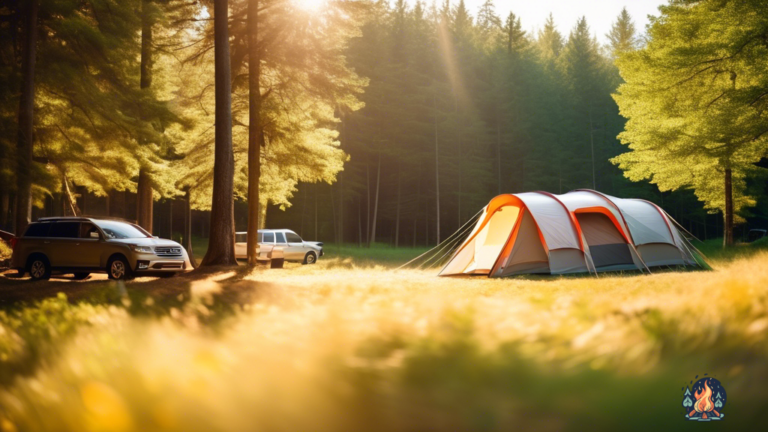Stay Safe And Secure: Essential Tent Safety Tips
by Kevin Fairbanks • Updated: January 30, 2024
Stay safe and secure during your next outdoor adventure with these essential tent safety tips. Don’t miss out on staying protected in the great outdoors – click here to read more!

Stay safe and secure as you embark on your next camping adventure with these essential tent safety tips.
Whether you’re a seasoned camper or a novice explorer, it’s important to prioritize your safety and well-being while enjoying the great outdoors.
In this article, we will guide you through the process of choosing the right tent for your needs, setting it up properly, and taking precautions to stay dry and protected in wet weather.
We’ll also provide tips on keeping wildlife and insects at bay, as well as safety measures for campfires.
So, grab a cozy blanket and get ready to learn how to create a safe and secure haven in the wilderness.
Let’s dive in!
Choosing the Right Tent for Your Needs
When selecting a tent, it’s important to consider factors such as size, weight, and weather resistance in order to find the perfect fit for your outdoor adventures. You want a tent that can comfortably accommodate you and your companions, without feeling cramped or claustrophobic.
The size of the tent should be determined by the number of people who will be sleeping in it, as well as the amount of gear you need to store. If you’re planning on backpacking or hiking, weight is another important factor to consider. You don’t want to be lugging around a heavy tent that will weigh you down and make your journey more difficult. Look for lightweight materials that are still durable and can withstand the elements.
Lastly, don’t forget to consider the weather conditions you’ll be facing. A tent with good weather resistance will keep you dry and protected from rain, wind, and even snow. Look for features such as waterproof materials, sturdy construction, and a rainfly to ensure that you stay safe and comfortable in any weather.
Now that you know what factors to consider, it’s time to find a tent that’s perfect for your needs. Take the time to research different brands and models, read reviews from other campers, and visit outdoor stores to see the tents in person. This will give you a better idea of the quality and features of each tent, helping you make an informed decision.
Don’t be afraid to ask for help from the staff at outdoor stores, as they’re usually experienced campers themselves and can provide valuable advice. Remember, the right tent is an investment in your comfort and safety during your outdoor adventures. So take your time, choose wisely, and enjoy the peace of mind that comes with knowing you have a reliable and suitable shelter for your camping trips.
Setting Up Your Tent Properly
Make sure you’ve got the perfect spot picked out before you start pitching your tent.
Look for a level area with no rocks or roots that could poke through the floor of your tent. You don’t want any surprises in the middle of the night!
Also, consider the surroundings. Are there any hazards nearby, like dead trees or an ant hill? You want to make sure you’re setting up in a safe and secure location.
Once you’ve found the ideal spot, it’s time to pitch your tent.
Start by laying out the tent body and aligning it with the direction of the wind. This will help prevent the wind from blowing directly into your tent.
As you assemble the poles, make sure they are inserted securely into the appropriate grommets or sleeves. You don’t want your tent collapsing on you in the middle of the night!
Use the stakes provided to secure the corners of the tent and tighten the rainfly for extra stability.
Finally, don’t forget to properly zip up the tent doors and windows to keep bugs and critters out.
With your tent set up properly, you can relax and enjoy a comfortable and safe night outdoors.
Staying Dry in Wet Weather
To ensure you stay dry in wet weather, it’s crucial to properly seal the seams of your tent. This will prevent any water from seeping through and ruining your camping experience.
Here are three essential tips to help you stay dry and cozy inside your tent even during the rainiest of days:
- Apply seam sealer: Before you head out on your camping trip, make sure to apply a seam sealer to all the seams of your tent. This will create a waterproof barrier and keep any moisture from getting inside. Be sure to pay extra attention to the areas where the fabric is stitched together, as these are the most vulnerable spots. By taking the time to seal the seams, you’ll be protecting yourself from any unexpected downpours.
- Invest in a quality rainfly: A rainfly is a waterproof cover that goes over the top of your tent, providing an additional layer of protection against the rain. Look for a rainfly that is made from a durable and waterproof material, such as nylon or polyester. Make sure it fits securely over your tent and extends beyond the sides and edges to keep the rain from dripping down inside. A well-fitted rainfly can make all the difference in keeping you dry during wet weather.
- Choose a high-quality tent with a bathtub floor: A bathtub floor is a type of tent floor that wraps up the sides of the tent, creating a bathtub-like shape. This design helps to keep water from pooling on the floor and seeping inside. When choosing a tent, opt for one with a bathtub floor and a high waterproof rating to ensure maximum protection from the rain. Additionally, make sure the tent is made from a sturdy and waterproof material to further enhance its ability to keep you dry.
By following these tips, you’ll be able to stay dry and comfortable inside your tent, no matter how wet the weather gets.
So go ahead and embrace the rain, knowing that you have taken the necessary steps to keep yourself cozy and dry during your camping adventure.
Keeping Wildlife and Insects at Bay
One effective way to deter wildlife and insects from your campsite is by using natural repellents. These can be found in many forms, such as citronella candles, essential oils, or even certain plants.
Citronella candles are a popular choice because they emit a strong scent that repels mosquitoes and other flying insects. Simply light one or two candles around your campsite and enjoy a bug-free experience.
Additionally, essential oils like lavender, eucalyptus, and peppermint can be applied to your skin or clothing to keep insects at bay. Not only do these oils smell great, but they also act as a natural repellent, providing you with added protection.
Finally, consider planting insect-repelling plants around your campsite, such as lemongrass, marigolds, or basil. These plants naturally release chemicals that insects find unappealing, helping to create a bug-free zone for you to enjoy.
In addition to using natural repellents, it’s important to keep your campsite clean and free of food scraps that may attract wildlife. Make sure to properly store your food in airtight containers or bear-resistant canisters to prevent animals from getting into your supplies.
It’s also a good idea to hang any food or scented items, like toiletries, from a tree branch using a bear bag or bear hang. This will keep them out of reach of curious critters.
Finally, be mindful of your surroundings and avoid setting up camp near areas that may be attractive to wildlife, such as sources of water or berry bushes. By taking these precautions, you can minimize the risk of encountering unwanted visitors during your camping trip and ensure a safe and enjoyable experience in nature.
Are Tent Safety Tips Different from General Camping Safety Tips?
When it comes to camping, essential camping safety tips are crucial for a successful trip. While tent safety tips are a part of general camping safety tips, they can differ in some aspects. It’s important to consider factors like weather, location, and terrain when preparing for a safe camping experience.
Safety Precautions for Campfires
Ensure your campfire is properly extinguished before leaving the area. This is one of the most important safety precautions you can take to prevent wildfires and accidents.
To ensure your campfire is completely out, follow these steps:
- Pour water over the fire: Use a bucket or a water container to pour water over the fire. Make sure to cover all the embers and flames with water. Stir the ashes and embers with a stick to ensure everything is wet.
- Feel for heat: After pouring water, use the back of your hand to gently feel for any remaining heat. Be cautious and make sure there are no hot spots left.
- Cover with dirt: Once you are certain there is no heat left, cover the fire pit with dirt or sand. This will help smother any remaining embers and prevent them from reigniting.
Taking these precautions will not only help keep you safe but also protect the environment. Remember, it’s your responsibility to leave the campsite as you found it, and properly extinguishing your campfire is a crucial part of that.
Now that you know how to properly extinguish your campfire, you can enjoy your camping experience with peace of mind. Stay safe and have a great time in the great outdoors!
Frequently Asked Questions
How do I choose the best location to set up my tent?
To choose the perfect spot for your tent, consider the terrain, proximity to water sources, and natural windbreaks. Avoid low-lying areas prone to flooding and choose flat ground for a comfortable night’s sleep.
What should I do if I encounter a bear while camping?
If you encounter a bear while camping, remember: stay calm and slowly back away. Contractions: don’t run or scream. Interesting statistic: Did you know that only 1 in 700 encounters with bears result in an attack?
Are there any specific safety precautions I should take during thunderstorms while camping?
During thunderstorms while camping, it’s crucial to prioritize safety. Seek shelter in a sturdy building or a hard-topped vehicle if possible. If caught outside, avoid open fields and tall objects. Stay safe and secure!
How can I protect my tent from strong winds?
To protect your tent from strong winds, use sturdy tent pegs and guy lines to secure it to the ground. Don’t forget to tighten the rainfly and keep the tent low to the ground for added stability.
What are some common mistakes people make when setting up their tents and how can I avoid them?
When setting up your tent, avoid common mistakes like not staking it properly, placing it on uneven ground, or forgetting to use a groundsheet. Stay vigilant and follow instructions carefully to ensure a secure and comfortable camping experience.

Hi, I’m Kevin, a lifelong camping enthusiast and the voice behind Campfire Discoveries. From tent to RV to cabin camping, I’ve explored it all. Join me as we share stories and tips around the campfire, deepening our connection with the great outdoors.
Keep Reading
-
Cabin Tents: Experience Camping In Comfort And Style
Experience the best of camping with cabin tents – luxurious comfort and stylish design await! Click now to elevate your outdoor adventures with a touch of luxury.
-
Making The Most Of Small RV Kitchens: Cooking Tips And Tricks
Looking to cook up a storm in your small RV kitchen? Check out these genius cooking tips and tricks for making the most of your space while maximizing flavor. Start whipping up delicious meals today!
-
Tent For Car Camping: Comfort And Convenience On The Road
Experience the ultimate comfort and convenience on your road trips with a tent for car camping. Discover how this essential gear can elevate your outdoor adventures. Upgrade your camping experience now!



